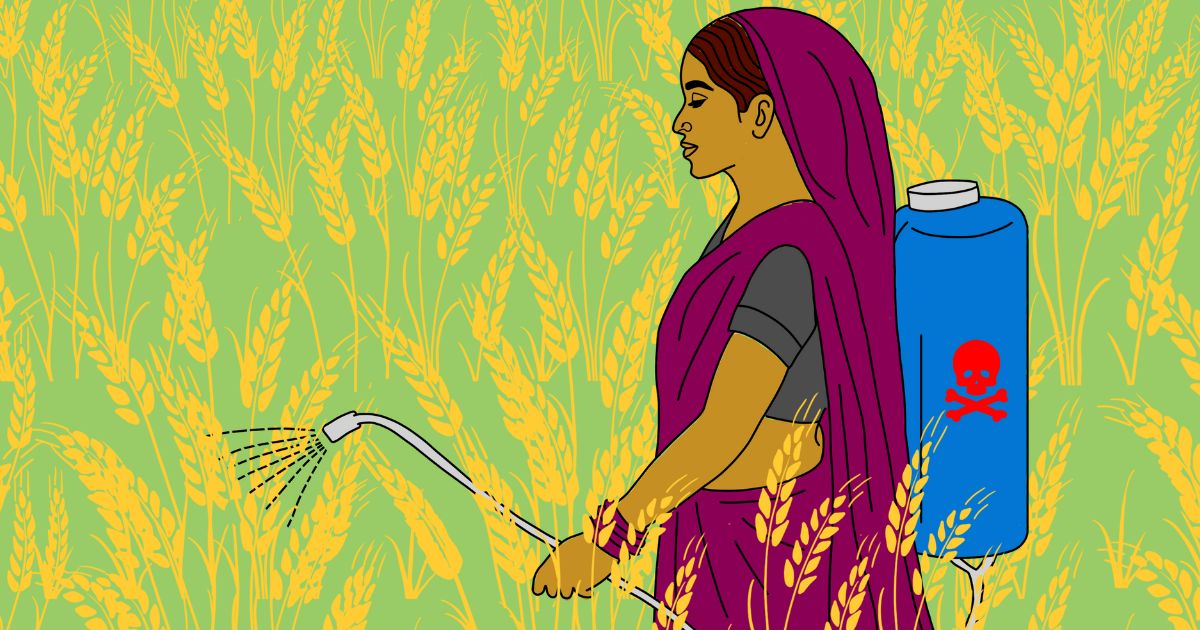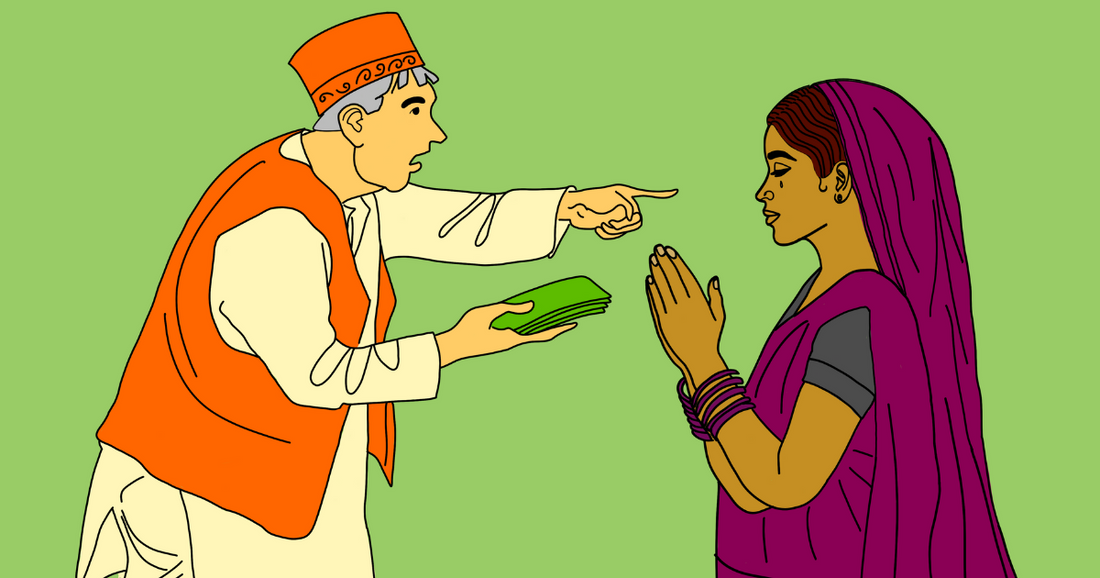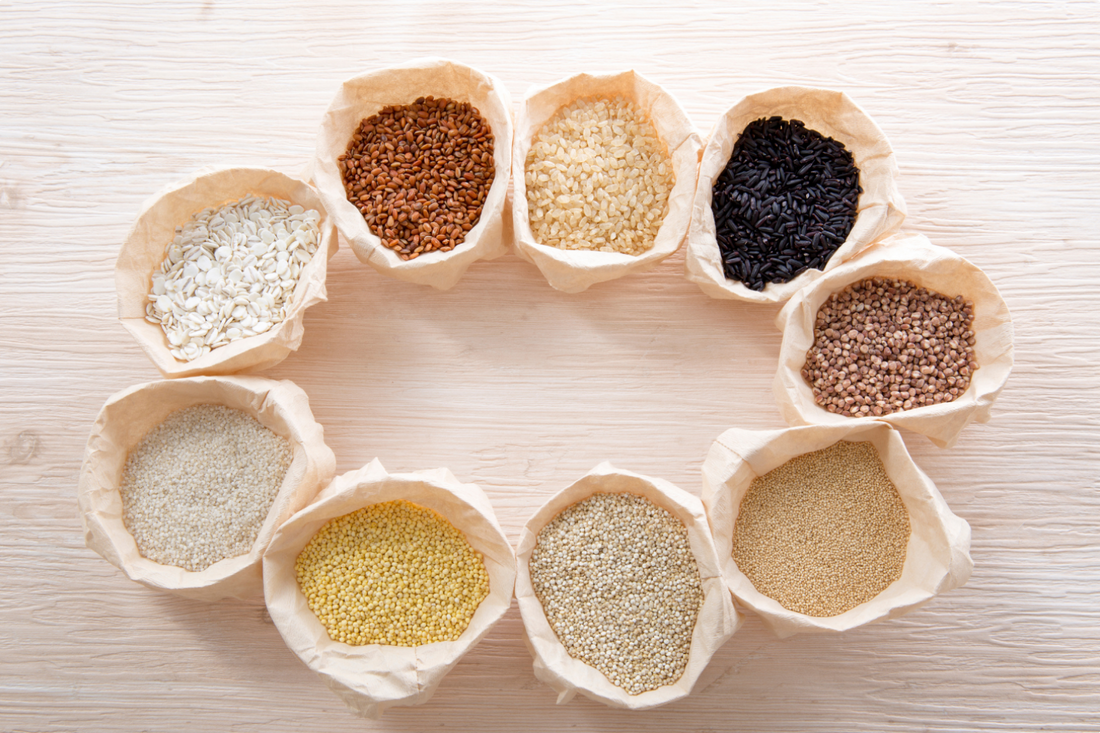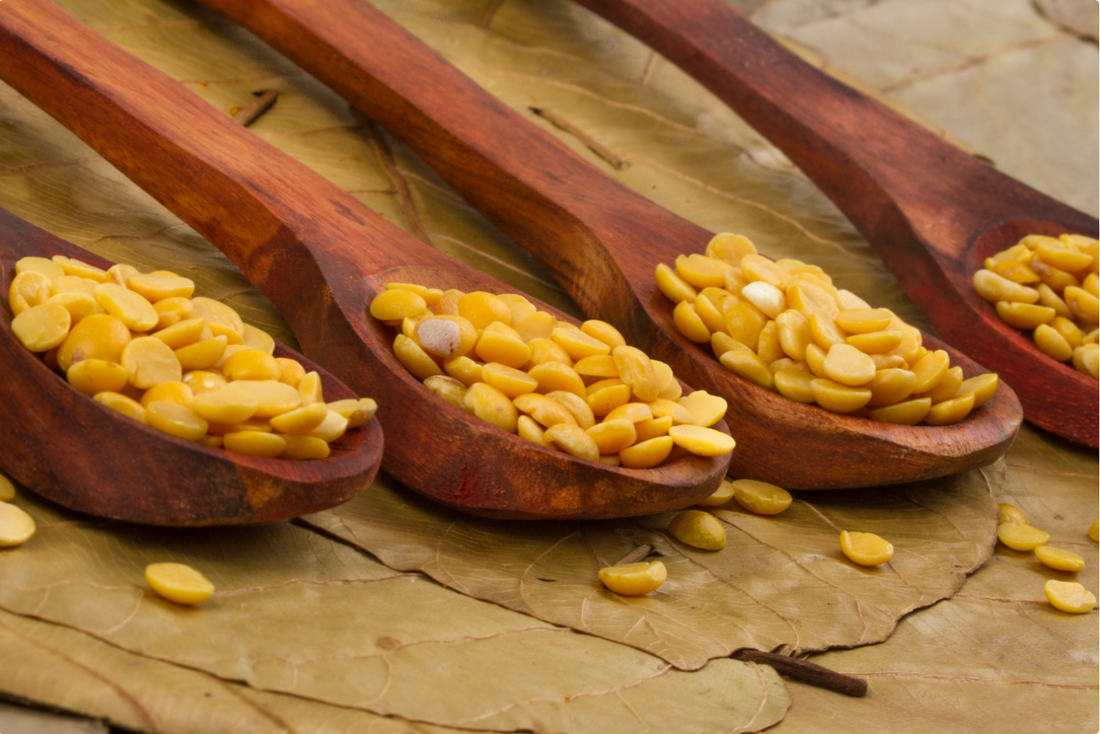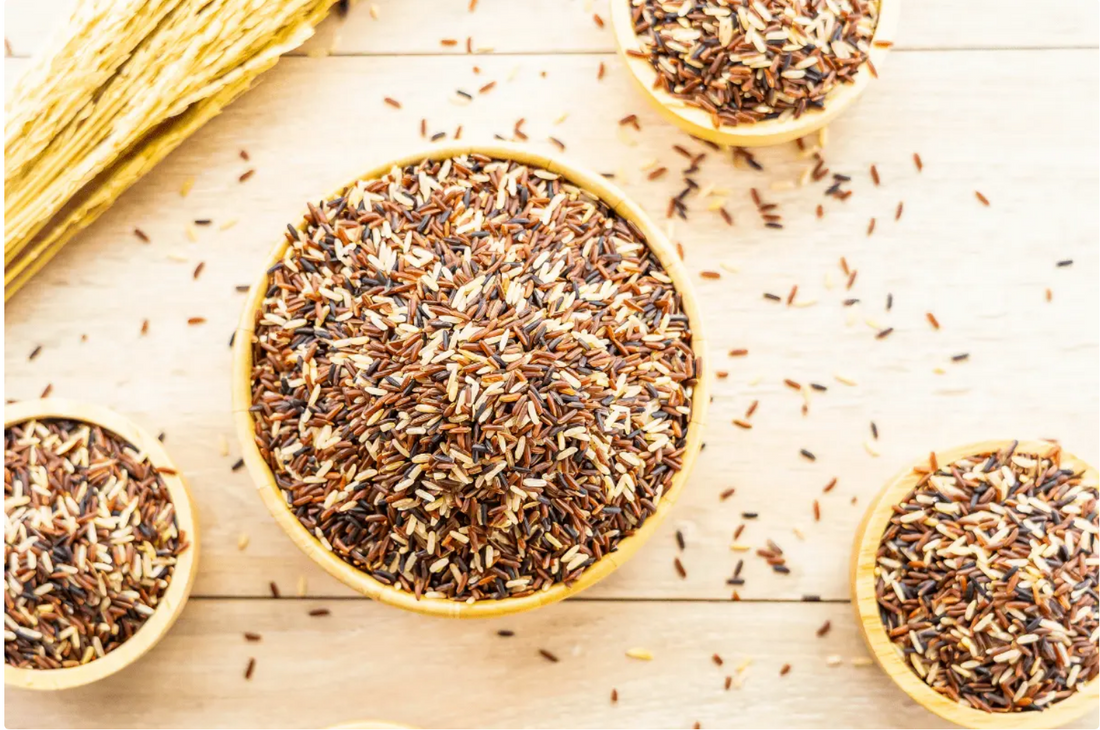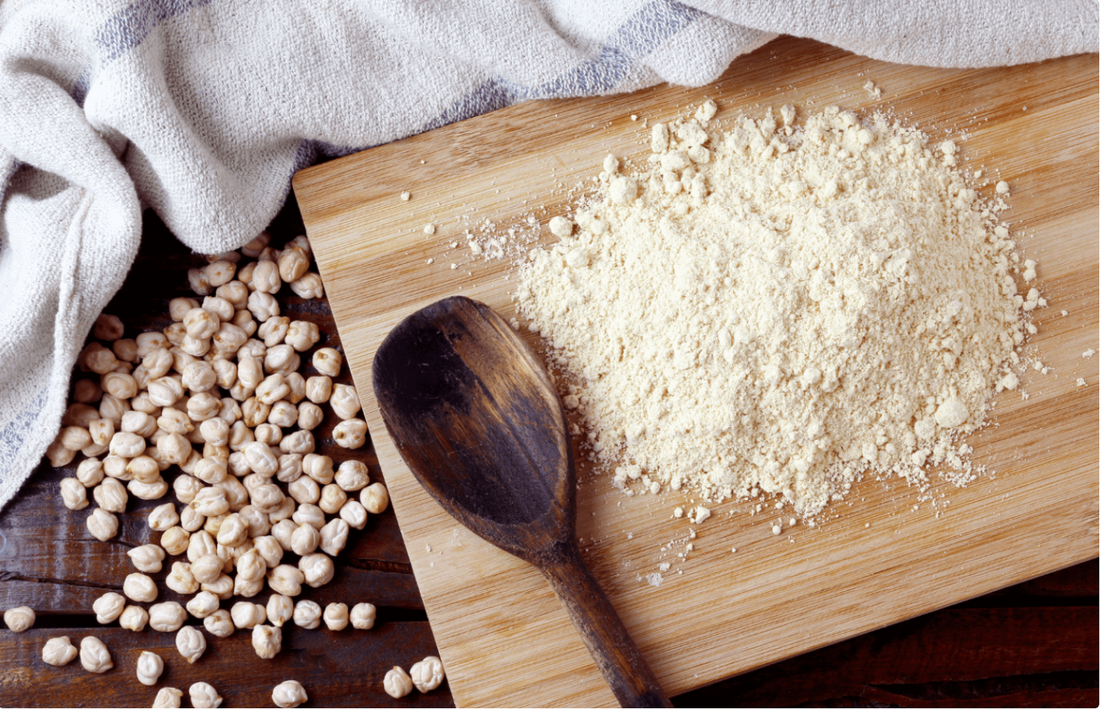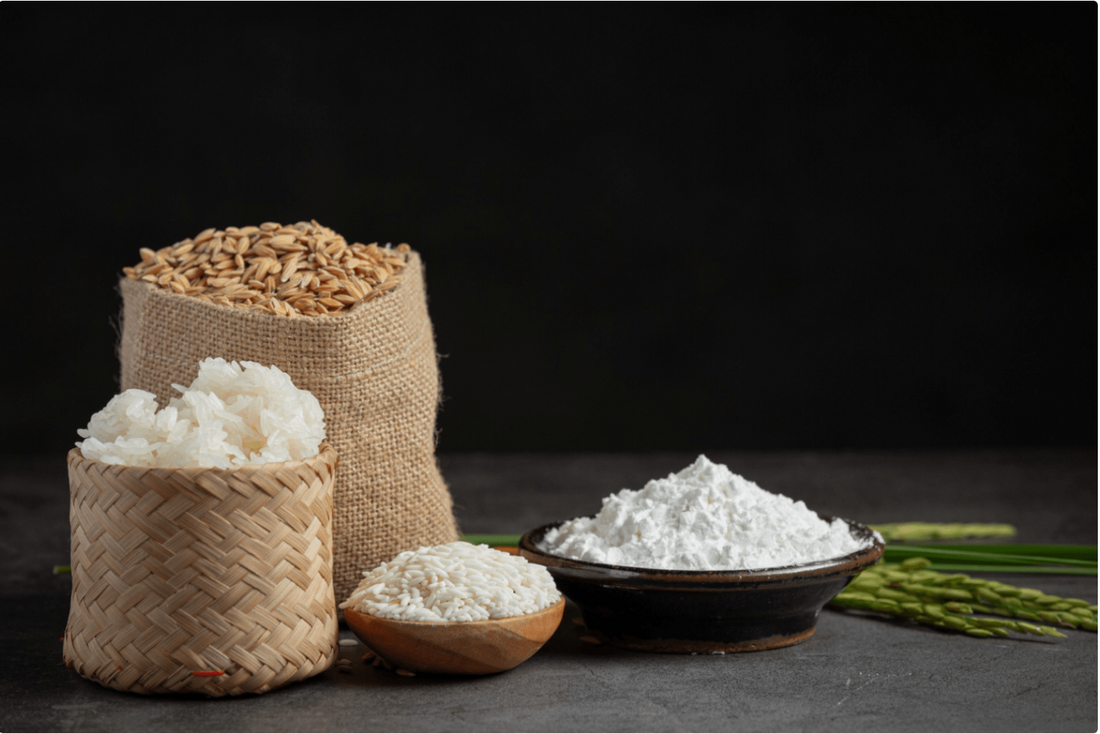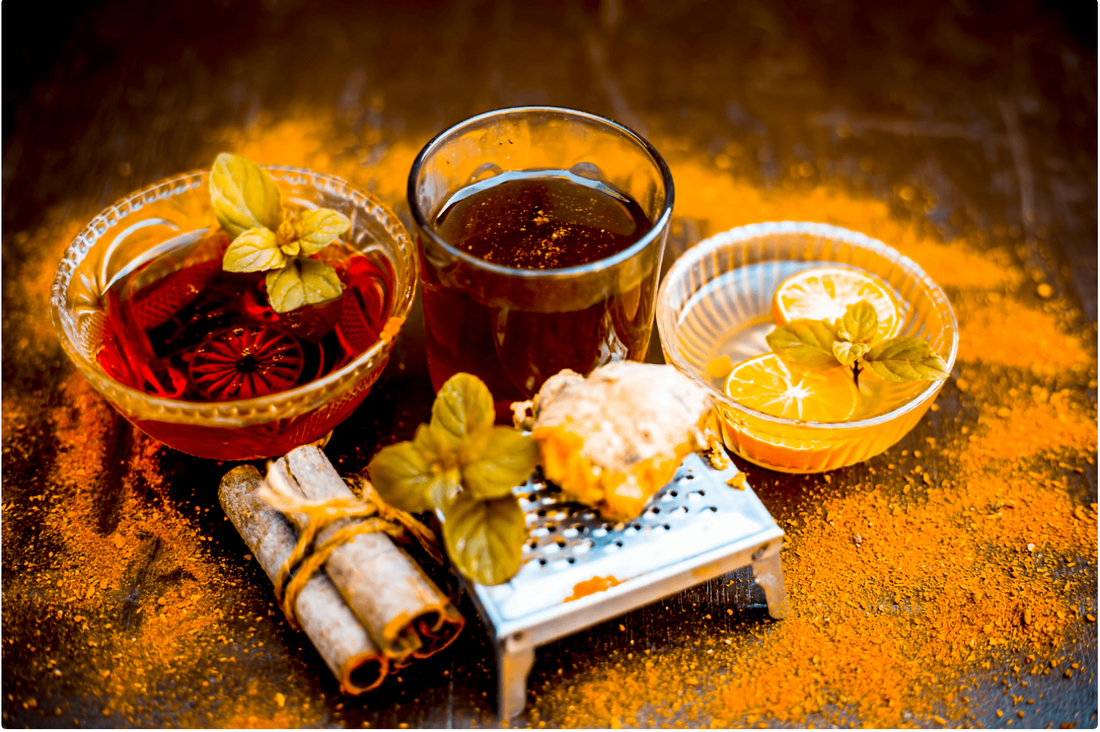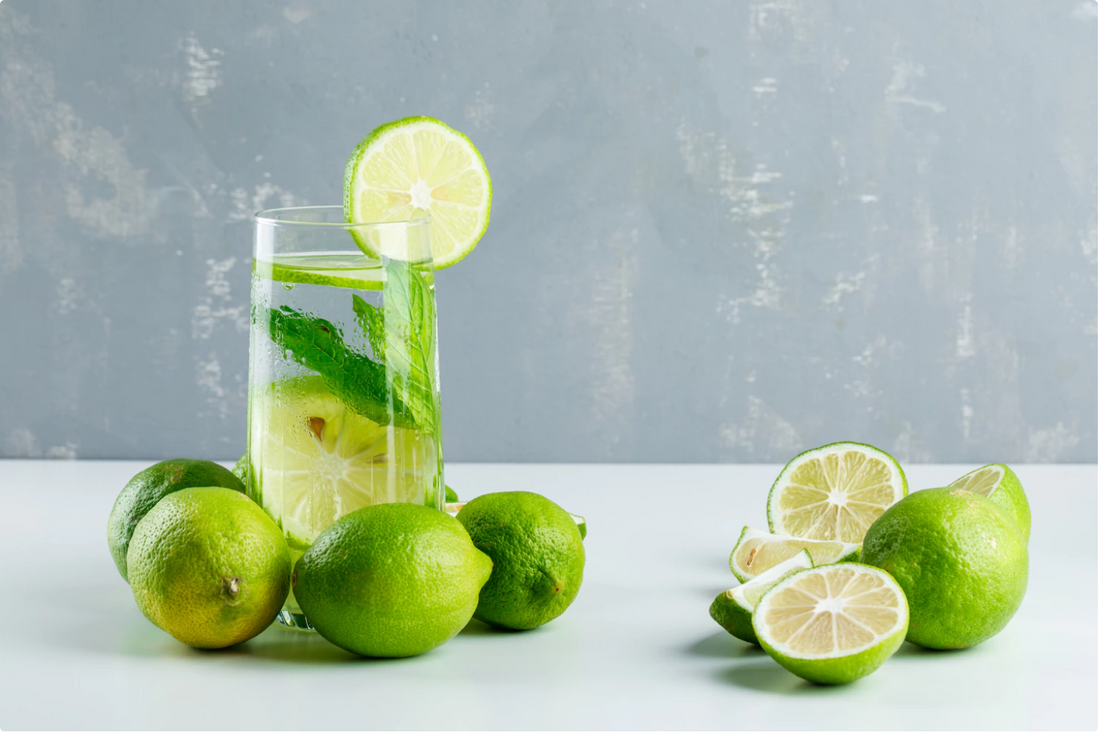Articles
What are Interlocked Markets?
Mira Bai does not remember the exact year she switched to the wheat-soy cycle. It was sometime in the late eighties, when her friends and neighbors, in the Adivasi district of Dewas in Madhya Pradesh, had begun adopting these crops. It was a miraculous cycle, they said: high-yielding and remunerative. Better than the ragged cotton, millets, and pulses she had been growing on her 2.5 acres of rainfed, semi-arid land. So she followed the current, tore out the hardy roots of jowar and tur, and planted soy in the monsoon followed by wheat in the winter. Hungry and vulnerable, these crops needed fertilizers and pesticides, many of whose names she couldn’t even pronounce. She didn’t have to leave the village to purchase them though. The local moneylender, whose shop stood prominently, had been keenly watching these changes. He had begun stocking pesticides and fertilizers, calling them dawai (medicine) and sarkari khaad (government manure) respectively. In a village where the intimidating bank-with its demands for documentation and collateral-remained out of reach, the moneylender assumed an outsized role. Though he lent at very high interest rates, sometimes upwards of 60 percent, he was always available and approachable. Mira Bai had in fact recently borrowed ₹5,000 to marry her daughter off. The moneylender, deeply attuned to the social rhythms of the village, had embedded himself into its ecosystem. He knew his debtors all too well, and sold inputs whose prices he had marked up, on credit too. He was aware that the nearest mandi, the formal regulated market, was 80 kilometres away. Renting a tractor would eat into farmers’ profits. There was also the ever present risk of the grain getting damaged en route. So, he would coax them to sell to him instead. In the absence of reliable price information, he quoted rock-bottom rates. To squeeze out even more, he used faulty weighing scales. Mira Bai and her friends knew they could get better prices at the mandi. They were well aware of the moneylender’s nefarious practices. Mira Bai also lived in constant fear of losing her only asset, land, to repay the ever-mounting interest. Her friend had already been forced to sell hers at a throwaway price to the same moneylender and move to the city. But she also had to weigh the risks. The moneylender, for all his predatory terms, at least showed up. What we have here is a classic case of interlocked markets. It is a system where a single actor provides credit, inputs and market access, making each transaction contingent on the others. No paperwork is needed. The obligation is baked into the rhythm of the farming year. Prices are adjusted. Debts are rolled over. New credit is offered. When farmers are unable to repay, their only asset, land, is taken over and at prices well below prevailing market rates. Worse still, their labour is exploited too, with the wages suppressed and the work, undervalued. Mira Bai never steps outside the orbit of this monopoly. She cannot. It is the convoluted architecture of dependency that bleeds farmers like her. By 2018, the average agricultural household in India, like Mira Bai’s, was carrying a debt burden of over ₹1 lakh, while earning just ₹77,000 annually from cultivation. There is no single exit from this trap. No silver bullet. What farmers like Mira Bai need is a new kind of ecosystem. One in which institutions are rebuilt with the farmer, especially the smallholder woman farmer, at the centre. Where credit is fair, timely, and accessible. Where agriculture is sustainable. Where markets are fair and are not held hostage by proximity and power. That is the work we at Safe Harvest, alongside our partners, have set out to do. To reinvigorate the institutions that once served farmers. And to build new ones where none exist. Because freedom for farmers like Mira Bai does not come from one good season. It comes from finally breaking the labyrinth that wraps itself around season after season. In the coming pieces, we will share how, through our own experience, sustainable agriculture, fair credit and accessible markets can work together to build a truly farmer-first ecosystem, one held together by the power of collective action. See you around…
Learn moreMillets -The Super Grain of 2023
There is a lot of hype and hoopla around Millets; with the UN declaring 2023 as the International Millet Year.A lot of Millet recipes are doing the rounds on social media, both indigenous and exotic alike. Home cooks, chefs, and established restaurateurs are out to promote the benefits of switching to millet-based cuisine. Right from the humble dosa up to the suave risotto, this food grain has indeed arrived! What is the big deal about Millets? Millets have been a part of our traditional and rural Indian diets for centuries. Millets are not just tasty but are packed with health benefits and help address health issues like diabetes, cholesterol, and weight loss. Millet is a highly underrated yet easy-to-grow sustainable crop suitable for any arid soil. They can be easily grown in regions where other cereal crops, like wheat, struggle because of their resistance to difficult growing conditions. Millets on the other hand require little water and ground fertility making them a sustainable and earth-friendly crop. Are Millets super-foods? Millets are of high nutritive value and are packed with health benefits. They are rich in protein, macro and micronutrients, vitamins, minerals, and amino acids. The food grain is gluten-free and contains both soluble and insoluble known as a “prebiotic,” which supports good bacteria and gut in our digestive tract. Grains like Bajra, Jowar, and Ragi – some millets have almost four times the iron available in brown rice, and three times the folic acid per serving. Bajra, or pearl millets, are possibly the cheapest source of protein, making them easy remedies to combat malnutrition in developing countries. Their health benefits- The calorie content of Millets is low and hence it helps with weight loss while keeping one satiated for a longer time. Millets have a low glycemic index and hence regular consumption of millets lowers the risk of developing diabetes. Since they are a great source of protein and essential fats, they boost immunity and bring down incidences of cardiovascular diseases. The potassium content in millet regulates blood pressure and helps the circulatory system to function better. Since it is rich in fiber, it helps digestion by alleviating bloating, gas, cramping, and constipation. A healthy digestive tract in turn helps avoid issues like gastric/colon cancer and kidney/liver complaints. Millets help the body detox with their antioxidant properties; Quercetin, curcumin and ellagic acid help flush out toxins from your body and neutralize the enzymatic actions of organs. Convincing enough? No? Let us tackle some commonly asked questions now: Don’t whole grains give you the same benefits? Millets contain much higher amounts of fiber along with essential minerals compared to wheat, rice, and other cereal grains. Don’t millets have a lot of carbs? Isn’t that bad for people who want to control their weight? While Idly, dosa or chapatti can be easily digested; it causes excessive insulin secretion leading to weight gain. Consuming millet is a slower process, and it is consumed less because of the fiber content present in them. If I eat lots of Millet am I going to get enough protein, iron, and other nutrients that are important for my health? Millets need to be consumed in moderate amounts because excessive consumption can lead to adverse effects. Excess can hamper the functioning of the thyroid gland and slow down digestion causing more issues for those with intestinal disorders. A balanced diet with all kinds of vegetables, a variety of millets, and fruits is that which is highly recommended to gain the maximum health benefits. Explore the world of Millets and indulge in their goodness for a healthy and sustainable lifestyle.
Learn moreSay Hello To A Fitter You This 2023! New Year’s Resolutions Through The Lens Of Good Health
Health needs to top every one of our resolutions this year, hands down. For we all have survived the worst – a global pandemic. New year or not; our eyes need to be focussed on the ball- good health. This said the dawn of a brand-new year rings in positivity, focus, and deep-rooted motivation that can push us toward health goals. So, should good health be considered the number one resolution? Without a doubt. What do healthy goals fetch in return? 1) The obvious. Keeping away from seasonal and lifestyle diseases.2) The strength to perform better in our lives, personally and at work.3) Most importantly, a fulfilled and peaceful mindset. One can be sure to discover a lot more benefits with a healthy lifestyle. Even otherwise are not the three solid incentives mentioned above enough, is it not? Yes, a plate of sugar-soaked jalebis and a pastry slathered with buttercream after a hearty meal can be a fitting finish to the evening. Pausing for a bit and not indulging will do a world of good in the long run. Just getting started with baby steps can set the ball rolling in the right direction.Now, how do you make well-defined, sustainable achievable health goals? 1) Simplest step one- Weigh yourself.How many of us weigh ourselves periodically? One doesn’t have to obsessively keep checking weight every day or after every meal. But once every fortnight should do. Keep a track of your weight and religiously make note of it in a small notebook. Let us slowly make this into a health journal as time passes. But begin. Seeing numbers go up or down on the scale gives a sense of reality. 2) Note down what you eat- include everything.Systematically note down whatever you consume. Be it a full-fledged meal, a snack, additional cups of beverages, or just everything that you eat. This may seem silly and you may be tempted to skip some steps but stick to this tradition. Carry around that little notebook and religiously jot it down. This is reality check number 2. The best way there is to knock sense into oneself is by seeing what is written in black and white. 3) Begin consuming a lot of water consciously.Wherever you are and whatever you do, indoors or outdoors. Begin drinking a lot of water, especially throughout the day. Always carry a measured bottle with you, set up an alarm, and drink up. Most of us confuse thirst with hunger and do not hesitate to reach out to junk when the throat dries up. Have a swig of water and still if you feel hungry have a bite. It may sound funny, but it is the truth. Water plays a significant role in metabolism and helps have a clean bowel movement. It keeps the skin hydrated and reduces unnecessary aches and spasms. Steps 1 to 3 are a primer to set the pace of your health and fitness goals. Keep at it. Let us move this up a notch 4) Focus on your notes in the little book- refresh your basics.With a clear understanding of how the numbers and the calories look. We can work up a diet plan. If you are really alarmed, consult a dietician. Otherwise, begin with these small changes that work for everybody, something you can easily stick to. Reduce processed foods, cut down your intake of refined sugar and oils, limit eating out and try to cook your meals. Chew your food very well, many of us have forgotten to do that. Breathe well, inhale and exhale properly in between chores. Now set an ideal weight target spread over a quarter. Choose an exercise, outdoors or indoors at a fixed time of the day. Exercise at least 5 days a week. 5) Include a substantial amount of fiber and protein in your diet.Now 80% percent of weight reduction lies in the diet. Consume more greens, sprouts, and fresh fruits. Proteins help burn fat and aids in the process of digestion. Consciously consume the ideal and required amount of proteins per day. Such a diet will also help in keeping you satiated for a longer time. You will gradually lose the craving to consume carbs and unnecessary sugar. 6) Track how many calories you burn.It is simple math, to lose weight you need to burn more than what you eat. It is here the notes help, for you will now have a fair idea of what you eat per day; figure out the type of exercise that helps you burn more. Remember this is a gradual process and it cannot be achieved overnight. Even otherwise, move around more. Use a step-tracker. Just be up and about as much as possible. All of this will help increase your basal metabolism rate. How do you define “good health”? There is a deep connection between the physical and mental state of the body. One influences the other without a doubt. To balance the connection between the two, it is first essential to nurture a positive state of mind to keep oneself constantly motivated. Never allow the mind to slack off with health targets. Likewise, staying active, and having fresh and nourishing meals can make one keep happy and have an optimistic outlook. Heavy and greasy meals can make one sluggish and slow down the mental process. Eat right, exercise regularly, and develop all the right lifestyle habits; for each of them heavily influences the other. It is also important to note here; the weighing scale is not an indicator of good or bad health. Occasionally indulging in a dessert is not a crime. Over exercising to burn away the additional calories the very next day itself is also not advisable. Each body is a different machine and therefore barring some fundamental habits, there is no standard template to achieve a defined target. There is no “ideal size” or a “body type”. It is perfectly okay to be off the perfect score by one kg or two. Your intake needs to make you feel good. Stick to natural foods; also start buying organic pesticide-free grains and supplies for your cooking. Exercising releases all “happy” hormones into your body; learn to enjoy the experience. Keeping good health is a journey, not a destination. The changes you wish to make need to be ingrained and slowly become a part of you. Brace yourself for the long haul. Conclusion:One resolution for 2023 is working towards keeping good health. Allow us to leave you with this thought- is there any other resolution you can possibly achieve without good health?
Learn moreThe Incredible Tur Dal: Obtain Quality Health Benefits At A Lower Cost
A piping hot bowl of wholesome dal not just warms the tummy, but benefits the heart and the overall health as well. Pigeon Peas or Tur Dal, Tur Dal as it is commonly known, is a quintessential staple across cultures in our country. Tur Dal features in various forms in Indian cooking. It is a storehouse of quality plant protein replete with multiple health benefits. Each state in India has its unique preparation that is absolutely lip – smacking and hence tur dal is a hearty essential in every meal! A brief history: Tur dal is a legume that belongs to the Fabaceae family and traces its roots to the Indian subcontinent at least 3500 years ago. Does it sound surprising that lentils had then traveled to Asia, Africa and Latin America and then were discovered by the Europeans? Today, Tur Dal is widely cultivated in most tropical and semitropical regions across the world; our country accounts for over 70 percent of the total production of tur dal. It is a drought-resistant crop and can easily be cultivated in regions with less rainfall. We have already talked about how Tur Dal carries out symbiosis with Rhizobia , the bacteria that help with nitrogen fixation of the soil in one of our previous blogs. There has been a discovery of path-breaking technology that can enhance the nutrient value of the grain as well reduce its cooking time. Why is Tur Dal cultivation popular? In India, this legume is cultivated as an annual crop, and it is the second most important pulse in our country in terms of production and consumption. It is grown extensively in Maharashtra, Andhra Pradesh and Gujarat. The Arhar or the Tur crop requires about 600-650 mm of rainfall in the first 8 weeks and drier conditions during the flowering and pod development stage. It needs moist and warm weather during germination and lower temperature during the vegetation growth phase. Waterlogging, heavy rains, and frost are harmful and can damage the crop. This crop is drought-tolerant because of its deep tap root structure. It grows well on all soil types, but sand-loam to loam is ideal. Traditionally the crop is intercropped with cereals, oilseeds, and other short-duration legumes. Climatic conditions prevalent in our country coupled with agricultural prerequisites to cultivate tur dal are favorable to our farmers; let us also not ignore that this legume is packed with health benefits and hence is widely in demand too. Where else is there a crop that protects the soil after harvesting? Tur Dal in our daily lives and its health benefits: Imagine the warm soup like tur dal spiced right, complete with a dollop of hot ghee, tempered with cumin seeds and cilantro leaves, served with piping hot rice. It reaches out directly to one’s soul and lifts spirits almost instantly. But is there all to it? There are a variety of dal preparations that are popular depending on the region it is used in. This unassuming protein-rich legume can assume the avatars of a rich north Indian Dal fry, a spicy south Indian Sambar, blends itself into spinach and turns into a protein powerhouse too! Remember always to rinse the tur dal in water and soak it for at least an hour before cooking. This helps in better absorption of nutrients in it and definitely quickens the pace of cooking it. Also, ensure that the tempering is always added in the end to enhance the flavor of the Tur Dal dish. Spend a little time understanding the quality of the Dal you purchase. High-quality Dal retains more nutritional value and has a better effect on health. Now, what are the health benefits of tur dal? Packed with protein:Tur dal is rich in good-quality protein, the building block of muscles, cartilage, and cells , which promotes repair and growth. Tur Dal combined with cereals delivers all essential amino acids that substantially serve the aforesaid objective. Protein consumption is critical to oxygenating cells in our body and plays a role in making enzymes that aid inthe digestion and absorption of food. Source of folic acid and Vitamin-B:Folic acid plays a key role during pregnancy; for the normal development of the baby and shields the baby against congenital birth defects of the brain and spinal cord. Tur Dal is packed with B complex vitamins vital for the normal metabolic process. Riboflavin influences metabolizing carbohydrates that prevent fat storage and enhances energy levels. Niacin in this legume has antioxidant effects that make the skin radiant and shields the skin from harmful UV rays. Rich in iron:Low hemoglobin levels can cause fatigue, irregular heartbeats, shortness of breath, and hair loss. Serious iron deficiencies can have more catastrophic effects on one’s health. Tur dal is a substantial source of plant-based iron and folic acid, and it pumps iron levels in the body naturally. It helps with weight management as it is a complex carbohydrate:Tur dal is intrinsically rich in protein and a source of complex carbohydrates, so it keeps one satiated for a longer time and controls hunger pangs. Since it is plant-based, it is also safe and highly suited for vegetarians. While the goodness of dietary fiber and a low glycaemic index helps in shedding weight by reducing the appetite, it triggers metabolism and reduces the intake of overall calories. Tur dal is low in saturated fats, and hence it is a super wholesome food for all weight watchers. Regulates blood pressure:Tur Dal or Pigeon pea is a good source of potassium that acts as a potent vasodilator or medicine that opens blood vessels. It, therefore, can regulate blood constriction and improves blood flow, thus keeping high blood pressure under control.Including Tur dal in the diet is highly recommended for hypertensive patients, as they are more susceptible tocardiovascular diseases. Improves gut health:Good gut health is a crucial indicator of overall well-being; digestive problems like bloating, indigestion and constipation are harmful and carry the risk of depleting essential nutrients from the system. in the needed amounts to the system. Tur dal is an effective digestive a stimulant that promotes overall digestion and improved gut health. Healthy for people with diabetes and boosts heart health:The Glycemic index of Tur dal is 29 making it highly suitable for diabetics. Since it is a good source of complex carbs and dietary fiber, it can boost metabolism and offer the body a steady energy supply. Just to note: foods low in GI keep one satiated for a longer time, delay digestion, and reduce blood sugar spikes. Since Tur dal is wholly devoid of saturated fats, it is a wise choice of protein for those with heart conditions. The abundance of dietary fibers and niacin helps enhance good HDL cholesterol levels and reduce harmful LDL cholesterol levels. Ultimately, there are fewer plaque deposits in the heart vessels, which eases cardiac muscle function and promotes overall heart wellness. Fortifies bones as it is rich in calcium, phosphorus, and magnesium:The consumption of tur dal is most important for growing children as it strengthens bones.It also plays a role in maintaining bone density in older people, bringing down the risk of osteoporosis. Magnesium is one of the key minerals actively involved in the execution of multiple bodily processes, uplifting both physical and mental well-being. Conclusion: To think of it, the affordable cost of tur dal, in fact, more than balances out the health. Do you agree? To buy Safe Harvest Pesticide Free Tur Dal – Safe Harvest Tur Dal
Learn moreBrown Rice – The Truth And Nothing But The Whole Truth!
A piping hot bowl of glistening white rice, with a dollop of ghee and golden yellow glimmering dhal on the side. Mouth-watering is it not? Now imagine the same setting and replace this gleaming white rice with earthy brown rice instead. That’s a lot of goodness combined! Now, what is all the hype about brown rice? Let us find out.Brown rice is considered the healthiest variety of type of rice, it is more nutritious than its white counterpart. Its outer protective shell called the hull (the bran and the germ layers) retains a significant amount of nutrients. These layers are removed by way of processing when manufacturers manufacture white rice. Brown rice is also higher in fiber, magnesium, and other nutrients. Health benefits of consuming brown rice: Digesting brown rice triggers the slow release of sugar into the blood and therefore it helps stabilize blood glucose levels. It is hence a smarter food choice for those with diabetes. Fibre-rich brown rice helps prevent carcinoma; in other words, these fibers attach to substances that cause cancer or toxins within the body and remove them from attaching to the colon wall. Brown rice is rich in powerful antioxidants that protect the body from damage caused by oxygen free radicals, using an antioxidant enzyme called superoxide dismutase. Due to the fiber content in brown rice, it makes digestion much easier and also helps in keeping the stomach full for a longer time. It is a whole grain that helps cut back the build-up of plaque and reduces the chance of cardiopathy and high cholesterol. What makes brown rice different from white and wild rice? Wild rice is actually a species of grass, with at least 30 percent fewer calories than brown rice as well as 40 percent more protein. Wild rice also contains more fiber, potassium, and zinc, and several times more manganese- a mineral needed for stronger bones and metabolic function. Brown rice and wild rice are both gluten-free and are healthy delicious alternatives to white rice.The germ, bran, and endosperm components present in brown rice are packed with differentminerals, vitamins, and proteins that offer nutritional value. White rice is generally stripped of these components during the processing stage. Brown rice contains more Niacin, phosphorous, and Vitamins B1 and B6 as well compared to white rice. How can you cook brown rice so that it stays healthy and tasty? Soaking any grain /legume before cooking as a thumb rule, enhances its nutritive value as well as hastens the speed of cooking. Choosing an organic brand while shopping for grains also makes a lot of difference in the quality of the output. Now with brown rice, take the required quantity in a bowl, and wash and rinse the rice multiple times to get rid of its impurities. Allow the rinsed grains to soak for about 15 minutes at least. You may also soak it for a longer time. Drain this water and empty the rice into a pot, add fresh water to it and bring it to a boil. Cover and bring this to a simmer for 15 to 20 minutes on low flame. By now the rice will be cooked. Switch off and allow this to rest for about five minutes. Open and fluff up the rice and allow this to rest for another 10 to 15 minutes. Brown rice is as versatile as white rice, healthier, and easier on the stomach. Sounds ideal does it not? Buy online : https://safeharvest.co.in/products/sona-masuri-unpolished-brown-rice
Learn moreHealth Benefits Of Pure Pesticide Free Besan Or Chickpea Flour.
Besan or gram flour is usually frowned upon by those who watch their weight; despite its role in the average Indian cuisine. Besan is no black sheep, for starters. Now it needs to be churned out into healthy recipes thereby enhancing its nutritive value. For those of us who merely associate Besan with pakoras (deep-fried fritters) or a sugar-rich halwa, it is about time we crawled from beneath the rock! Chickpea flour or Besan has a wide range of health benefits such as aiding in better digestion, improved immune system, and reduced risk of diseases. It is rich in protein, and folate and is packed with antioxidants, minerals, and vitamins; highly recommended to complete a balanced meal. It is a wise alternative to wheat flour as it is lower in carbohydrates yet richer in protein and fiber. Health benefits of Gram flour/Besan: Promotes satiety and weight loss: Gram flour combines both protein and fiber and has a low glycemic index all of which help feel full faster thereby reducing the portion of the meal. It is heart-friendly and has low cholesterol levels: A diet rich in non-soy legumes helps lower the total and LDL cholesterol levels thus making it ideal as a heart-friendly food. Food for good gut bacteria and bowel health: The beneficial bacteria which live in the large intestine is sustained by resistant starch found in gram flour. Now, these bacteria help protect the body from metabolic diseases, such as obesity, colon cancer, etc. High dietary fiber intake is associated with improved bowel movement, increased frequency, and easy bowel movement. Safe for Diabetics: The presence of fiber helps reduce the absorption of dietarycarbohydrates and hence it does not spike blood sugar levels. Gluten-free diet: Since chickpeas are a product of legumes; it is gluten-free. But one must ensure the purchase of a pure unadulterated product with less to no chances of cross-contamination from production or packaging equipment. Good in the prevention of Anemia: Gram flour is a great source of calcium and iron and plays a role in red blood cell production. Reduces Inflammation: Gram flour has butyrate, a short-chain fatty acid that reduces colon inflammation. It is also a great source of vitamin B that helps to increase immunity levels. Good for bone and brain health too: Gram flour has calcium and magnesium both of which helps in strengthening bones. Magnesium also relaxes blood vessels and allows more blood to flow into the brain. Besan is not just packed with nutritional values but it is one of the most effective home remedies for skin care. Besan face packs help tighten and lighten the skin while maintaining its elasticity. A spoon of gram flour mixed into a paste with milk and a dash of turmeric, and there your face pack is ready in a jiffy! Apply this to your face and neck, allow it to dry, and rinse off with plain water. Moisturise and there you are all set with glowing skin! Now, do you agree that Besan/gram flour should not be underrated anymore?
Learn moreA Taste Of India – Rice Flour Recipes From Across Our Country
No kitchen is complete without this versatile staple- freshly ground rice flour. This all-season flour finds its place in breakfast, lunch, dinner, or in delicious snacks as well. First things first. The humble rice flour is gluten-free, rich in nutrients, and is a wonderful choice for those who suffer from gluten intolerance and autoimmune conditions such as Celiac. A high-fiber diet can help control blood sugar levels, promote regular bowel movements, and improve cardiovascular health. Since rice flour is high calcium content, it is a fantastic food option for maintaining bone health. Brown rice flour in particular is rich in higher levels of Vitamin B, as brown rice has its outer husk intact. Essential nutrients found in the husk are vitamins, and minerals such as calcium and zinc. Rice flour is essentially clean rice ground into a fine or coarse powder depending on the dish it is used to make. Let us look at some easy, healthy rice flour-based recipes. Dosa: This south Indian delicacy is usually served with chutney (a coconut-based dip) and sambar (lentil-based curry) and is heavenly when served out. Mix rice 3 portions of rice flour with 1 portion of soaked and ground whole urad dhal and allow this batter to ferment for 4-5 hours. Pour dollops of this batter, and spread it out like a pancake into a hot greased pan. Serve hot and crisp. Modak: Modak is a type of dumpling and is very popular in Maharashtra and made to mark theoccasion of Ganesh Chaturthi. The Modak has a soft outer cover made of cooked rice flour-based paste and has a filling of grated coconut, ground nuts, and jaggery. It is steamed well and served hot. Rice Phirni: Rice phirni is a famous north-Indian dish and is made by cooking rice flour slowly in thicksweetened milk. This is then garnished with sliced almonds, pistachios, and cardamom and served chill. A delectable dessert, a standard in festivals of the north. Rice Chakli: A popular snack in Tamil Nadu, Karnataka, and Andhra, the rice chaklis or the murukkus are deep-fried snacks made from a mixture of rice flour, roasted gram flour, butter, and a spice mix. Using a mold or a chakli maker, the well knead dough is shaped and deep fried in oil into a circular, spiky shape using chakli maker. This snack can be stored in an air-tight container for a few weeks and consumed. Idiyappam: Idiyappam is a famous Kerala breakfast item; a soft thin rice noodle dish served with a mild stew. It is made from a dough of rice flour which is first cooked and then molded intonoodles and steamed. It is served hot, with coconut milk or a mildly spiced vegetable stew. A healthy, wholesome meal. Rice Khichu: This steamed rice flour dish is a go-to quick snack in Gujarat. With barely any oil usage the rice khichu is quick and easy to prepare. It is a dollop of cooked spiced rice flour with a little oil and gunpowder on top and served straight out from the pan!Rice flour is also used as a coating that can absorb moisture to ensure that deep-fried snacks are crisp once they are out of the hot oil. Uses for the rice flour can be endless; ensure that your pantry is well stocked with generous amounts of rice flour at all times.
Learn moreSimple Tips To Keep Away The Flu- A Healthy Dose Of Exercise And A Good Diet Helps
As much as the monsoon seems like a respite from the sweltering heat; it is a season of all kinds of infections. Sniffling noses, relentless coughing, and general overall fatigue can be a downer in the family. The flu season is predictable most of the time, year after year, so a little bit of preparedness will not hurt, will it? Little things matter, beginning from drinking a lot of warm or hot water. Washing your hands and feet after every visit outside the house. Steam inhalation when you sense a slightly scratchy throat. Let us go through more of what you can do to prevent falling sick. Consume organic and pesticide-free food as much as possible- Flu season or not, this is highly recommended. It is essential to pay close attention to the food we consume, and the water and air intake that happens. Clean water, air, and food grains help build overall immunity. Eat right, think right, and feel right – Your body is your temple, sounds cliché? It is the truth, it houses you and you better ensure it is nurtured well. Do not dump your stomach with oily snacks in the name of enjoying the weather outside. You can still munch on a healthy salad and feel good. It is also what you eat that makes you feel good. Think happy thoughts, and nurture a positive attitude at all times. Strike a balance between your mental and physical state- Start by being mindful. Find a healthy diet that suits you and stick to it, and throw in some variety and colors in your meals. Watch your portions. Follow the same rule for your mind. Indulge in a variety of activities, consume positive content and keep supportive relationships. Do not obsess over weight, size, and looks beyond a point. More than anything, never panic at the sign of falling sick or hearing about it. Exercise and enjoy doing it- Never take up something that does not excite you. Pick a physical activity that you enjoy participating in and something that can easily become a habit. What is important is you need to be consistent and get better at it. Never allow your mind to slack. Listen to your body and progress. Exercise is for all seasons, summer, spring, and winter. Flu season or not. Regular exercise benefits the body and mind both. Stock up and have home remedies handy- Spices and condiments like ginger, clove, and ajwain (carrom seeds) provide relief from cough and cold. They are safe and can be quickly boiled in water and consumed as a tea. In case you have caught an infection, rest up, consume a lot of hot soup and drink a lot of fresh water (preferably hot). One only can gradually build good health and stamina to help fight minor infections, it does not happen overnight. Nutritious food prepared from organic food grains, plenty of exercise, and hydration are three important aspects of an overall healthy lifestyle. Following a regimen will make fighting the flu effortless.
Learn moreBinge-Eating Breakfast Is Blasé – Switch To Super-Charger Smoothies And Juices
It is essential to ring in a healthy start to the day; whatever you may have had for dinner the previous night. Remember that in an ideal scenario (also advisable) your stomach would have been empty for at least 12 hours. Breakfast is undoubtedly the most important meal of the day, but it is certainly not advisable to have a full meal just after you wake up. Your internal organs need time to wake up and kick start and function after a long night. You should consume breakfast at least 2 hours after waking up. Begin with a drink…a healthy juice. Lemon juice with warm water and a dash of honey has to be your early morning elixir. What does it do? Flush out all the toxins of the previous day via a healthy bowel movement. How good does that sound? In the mood for something a little fancier? Brew a wicked ginger tea. Boil the ginger root in hot water for about 5-10 minutes. Add a dash of lemon and honey. Ginger tea is packed with potassium, magnesium, copper, Vitamin C, and B6. There are just unlimited benefits of ginger for our body; allow us to name a few. It boosts metabolism; as mentioned earlier, by increasing thermogenesis or production of heat in the body by breaking down fat. It helps manage blood sugar as it helps thwart oxidative stress (imbalances due to excess free radicals in body cells due to metabolism) It can help manage blood pressure and support health by preventing blood clots, relieving heartburn, and lowering cholesterol. It helps in relieving pain and inflammation due to its anti-inflammatory properties. Here is a pro-tip- Grind well-cleaned and peeled ginger into pulp with a little water add a dash of lemon and salt and store it in a clean jar in your fridge. Take a couple of spoons every morning mix in hot water and gulp it down! Bored with Ginger? Try Aloe vera juice. Cut off chunky portions of the aloe vera leaf- scoop out the pulp and blend it in well with water. Consume. Aloe vera also has anti-inflammatory properties and also actively helps in digestion. A bonus- it restores the shine in your skin and hair! Fennel, Mint, and Cinnamon are all active agents of busting stomach-related issues, indigestion, helping relieve muscle cramps, etc. They help detoxify the system, restore balance in the digestive tract and promote weight loss. What is an ideal breakfast diet? Follow a simple routine- the direction of the sun. The sun just about gets ready for a long day ahead early in the morning, as does your digestive system. It blazes between 12 and 2 and hence that’s when your metabolism is the highest. Breakfast which is usually consumed between say 9 and 10 am needs to be a cooked light meal, combine it with soaked dry fruits and nuts, a little bit of dairy say milk or cheese and fruit. Reserve heavy and complex carbohydrates for an early lunch. Never forget to start your day with healthy juice. Now mix, and match your juice but do not skip drinking one!
Learn more